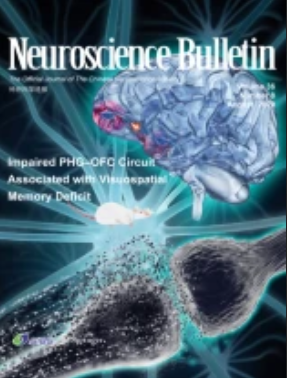A Novel Mouse Model Unveils Protein Deficiency in Truncated CDKL5 Mutations.
IF 5.9
2区 医学
Q1 NEUROSCIENCES
引用次数: 0
Abstract
Mutations in the cyclin-dependent kinase-like 5 gene (CDKL5) cause a severe neurodevelopmental disorder, yet the impact of truncating mutations remains unclear. Here, we introduce the Cdkl5492stop mouse model, mimicking C-terminal truncating mutations in patients. 492stop/Y mice exhibit altered dendritic spine morphology and spontaneous seizure-like behaviors, alongside other behavioral deficits. After creating cell lines with various Cdkl5 truncating mutations, we found that these mutations are regulated by the nonsense-mediated RNA decay pathway. Most truncating mutations result in CDKL5 protein loss, leading to multiple disease phenotypes, and offering new insights into the pathogenesis of CDKL5 disorder.
一种新的小鼠模型揭示了CDKL5突变缺失中的蛋白质缺陷。
细胞周期蛋白依赖性激酶样5基因(CDKL5)的突变导致严重的神经发育障碍,但截断突变的影响尚不清楚。在这里,我们引入cdkl542stop小鼠模型,模拟患者的c端截断突变。492stop/Y小鼠表现出改变的树突脊柱形态和自发的癫痫样行为,以及其他行为缺陷。在创建了具有各种Cdkl5截断突变的细胞系后,我们发现这些突变受到无义介导的RNA衰变途径的调节。大多数截断突变导致CDKL5蛋白丢失,导致多种疾病表型,并为CDKL5疾病的发病机制提供了新的见解。
本文章由计算机程序翻译,如有差异,请以英文原文为准。
求助全文
约1分钟内获得全文
求助全文
来源期刊

Neuroscience bulletin
NEUROSCIENCES-
CiteScore
7.20
自引率
16.10%
发文量
163
审稿时长
6-12 weeks
期刊介绍:
Neuroscience Bulletin (NB), the official journal of the Chinese Neuroscience Society, is published monthly by Shanghai Institutes for Biological Sciences (SIBS), Chinese Academy of Sciences (CAS) and Springer.
NB aims to publish research advances in the field of neuroscience and promote exchange of scientific ideas within the community. The journal publishes original papers on various topics in neuroscience and focuses on potential disease implications on the nervous system. NB welcomes research contributions on molecular, cellular, or developmental neuroscience using multidisciplinary approaches and functional strategies. We feature full-length original articles, reviews, methods, letters to the editor, insights, and research highlights. As the official journal of the Chinese Neuroscience Society, which currently has more than 12,000 members in China, NB is devoted to facilitating communications between Chinese neuroscientists and their international colleagues. The journal is recognized as the most influential publication in neuroscience research in China.
 求助内容:
求助内容: 应助结果提醒方式:
应助结果提醒方式:


